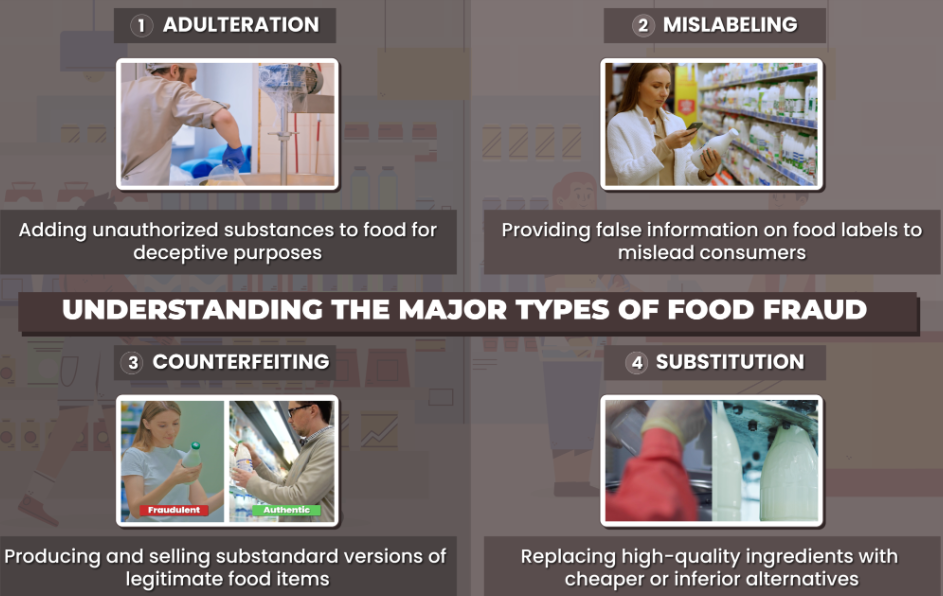
As per U.S. FDA experts, food fraud affects 1% of the global food industry at a cost of about $10-$15 billion a year, although some more recent expert estimates put the cost as high as $40 billion a year.
Economically Motivated Adulteration (EMA), primarily known as food fraud happens when an individual deliberately excludes, removes, or replaces a crucial ingredient or component of a food item. Having a thorough grasp of the potential occurrences of food fraud within any sector of the food industry, coupled with the implementation of suitable preventive measures, is imperative for any food enterprise to safeguard its interests and flourish in the contemporary market landscape.
Food fraud refers to the deliberate manipulation, mislabeling, substitution, or tampering with any food item within the entirety of the farm-to-fork chain, spanning from production to consumption. It involves deceitful actions like intentional substitution, dilution, or addition to food products or their components, as well as misrepresentation, all driven by motives of financial gain or causing harm. These actions aim to either enhance the perceived value of the product reduce production costs, or even inflict harm through malicious contamination.
Given below are the most prominent categories of food fraud with respective examples of a food fraud incident.
Adulteration; the addition of unauthorized substances to food products to increase bulk, weight, or perceived quality. Adulterants may include cheaper or inferior ingredients, such as diluting olive oil with lower-grade oils or adding undeclared fillers to spices.
Mislabeling; intentionally misleading consumers by providing false or inaccurate information on food labels. This may involve misrepresenting the origin, quality, or composition of a product, such as labeling farmed fish as wild-caught or mislabeling conventional products as organic.
Counterfeiting; producing and selling counterfeit versions of popular or high-value food products. Counterfeit foods may be manufactured using inferior ingredients or substandard production methods, posing health risks to consumers.
Substitution; replacing one ingredient with another of lesser value or quality without disclosure. For example, substituting a cheaper species of fish for a more expensive variety or replacing premium coffee beans with lower-grade alternatives.
Addressing food fraud risks requires a concerted effort from all stakeholders involved in the food supply chain, including producers, manufacturers, distributors, retailers, regulators, and consumers. Here’s an overview of key measures for mitigating food fraud risks:
Supply Chain Monitoring
Companies should
Establish mechanisms for monitoring procedures and methods effectively.
Maintain detailed records of corrective actions to be taken if mitigation strategies fail or are not implemented correctly.
Verify the proper execution of monitoring activities and adherence to corrective measures.
Vulnerability Analysis
Conducting risk assessments and vulnerability analyses is pivotal for identifying potential vulnerabilities in the supply chain and prioritizing mitigation efforts. VACCP, or Vulnerability Assessment and Critical Control Points, not only targets food fraud but also expands its focus to include the systematic prevention of any possible food adulteration, whether deliberate or unintentional, by identifying vulnerable points within a supply chain.
Training & Awareness
Establish food fraud awareness training across all organizational departments, including Procurement and Operations, to foster a deep understanding of key principles. Set up clear procedures for handling non-compliant products and emphasize the importance of utilizing accredited testing laboratories and requesting Certificates of Analysis. Staff should also be educated on the impact of harvest cycles on product availability and quality to enhance overall vigilance and integrity in our supply chain management practices.
Supplier Qualification
Employing rigorous supplier verification programs and conducting regular audits of suppliers’ facilities are essential for ensuring the integrity and safety of the supply chain. Experts emphasize the importance of verifying the authenticity and quality of raw materials and ingredients and conducting thorough due diligence on suppliers’ practices and processes.
Ingredient Verification
Execute procedures to ensure the authenticity of ingredients, including rigorous verification processes by implementing testing programs specifically designed for highly vulnerable materials to maintain product integrity. Regularly conduct equipment maintenance and calibration to uphold operational efficiency and accuracy.
Traceability & Transparency
Set up traceability protocols, consisting of actions such as urging suppliers of sensitive products to undertake mass balance assessments, integrating suitable anti-counterfeit technologies, and verifying adherence to import regulations, Good Manufacturing Practices (GMP), and prevailing industry benchmarks.
Regulatory Oversight
Strengthening regulatory oversight and enforcement contributes to deterring food fraud and holding perpetrators accountable. It means to say that actively engaging with relevant authorities to report suspected cases of food crime, fosters a culture of responsibility.
Consumer Education
Educating consumers about the risks of food fraud and empowering them to make informed purchasing decisions is essential for combating fraudsters’ deceptive practices. Experts recommend providing clear and accurate information on food labels, certification seals, and quality assurance programs to help consumers identify authentic and trustworthy products.
As food industry experts continue to innovate and forge new strategies for combating food fraud, they will remain principal to staying ahead of emerging threats and protecting consumers from harm.
Smart Food Safe presents a consolidated array of digital modules, which can serve to curb instances of food fraud, supporting food businesses to maintain the highest levels of quality, food safety, and regulatory compliance.
Our platform furnishes powerful functionalities for managing supplier relationships, conducting risk assessments, and ensuring strict adherence to Hazard Analysis and Critical Control Points (HACCP) protocols. The integration of risk and vulnerability assessment within Smart Supplier enables the identification of potential points susceptible to food fraud in the incoming materials in a food industry. By designing product verification requirements in Smart Specification and confirming them in Smart Compliance, the system ensures rigorous testing and verification processes, thereby minimizing the risk of fraudulent materials entering the food production process. In instances where deviations occur, Smart CAPA can assist food companies in executing swift corrective and preventive actions, reinforcing overall fraud mitigation efforts.
_1.png)